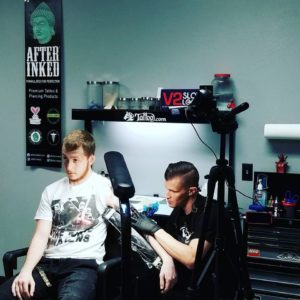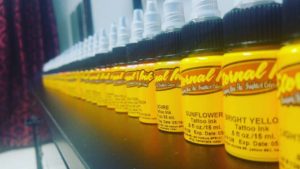I’m sure you’ve heard the cliché phrase, “starving artist.” This statement has been echoed throughout time, following anyone who chooses to follow an artistic path in life.
Luckily, for artists who opt to move into the tattoo industry, tattoo art has gained a popularity over the years of its existence. This popularity has actually warranted many tattoo artists to become quite profitable in this form of artistic expression. For some, they have reached heights of riches and fame. For others, they make enough to pay bills and support a family. Of course, there are some, unfortunately, who barely scrape by.
Choosing to be a tattoo artist as a full-time career can be terrifying for many. Especially for those who live on their own, have families, or need to create a specific amount to survive. The industry has its ups and downs, with regulations on tattoos constantly changing in the workforce. They are an expensive hobby—not a requirement. This means that when the economy starts tanking, nobody needs tattoos.
But, let’s face it… tattooing has been around for thousands of years. It’s something that has been embedded in our culture for as long—in fact, longer—than written history. It won’t fizzle out entirely, but it does see drastic periods of slower workloads.
 While these down periods can be upsetting for tattoo artists, there is something much more frustrating that occurs on a daily basis.
While these down periods can be upsetting for tattoo artists, there is something much more frustrating that occurs on a daily basis.
This occurrence which plagues tattoo artists the most is the way many tend to look at them—as a charity.
There are many clients out there who understand that you get what you pay for. You want a good piece of artwork, you are going to have to pay the price for a good artist. These clients are great in the fact that they don’t haggle, they don’t argue, they don’t barter. They simply quote out the piece and save up for the best quality of work.
There are some clients who want tattoos without the effort of saving and will settle for work that is less than great. Those clients are great, too. They’re not in the higher-end, high caliber shops debating prices. They are happy with their run of the mill, moderate quality tattoos. In all reality, the early days of tattooing’s rebirth were filled with lower-quality, quickly inked pieces, so it is no surprise that there is still a category of people who are happy with average work vs expensive, large-scale pieces. To each their own.
But, the client which tattoo artists dread dealing with the most are the self-proclaimed “friends…”
Remember that kid in your science lab class in 6th grade who sat directly behind you? Yeah, well, he’s now standing in your lobby for a consultation. Let me give you a rundown of how this conversation is going to go…
Client: “Hey man, I’ve been watching your stuff online. Killer work. I’ve got an awesome piece you’re just going to want to do.”
Artist: “Thanks! So, tell me about this epic piece you’re wanting.”
Client: “I want an American flag running all the way down my arm with a flying, realistic, full-color eagle hovering above it.”
Artist: “Uh, okay. Well, that would require a full custom drawing and several sessions. My outer panels start at roughly $1,200, so for a full color, realistic full-sleeve you are looking between $2,400-2,800 broken down into several sessions.”
Client: “What? That’s insane. I thought we were cool, bro? Can’t you just cut me a deal on the price? I was thinking like $200 total. I mean, we’re tight. It’s not like it’s going to cost you hardly anything.”
And, this, ladies and gentlemen, is a tattoo artist’s daily struggle.
There are groups of individuals who believe that because they had a class with the artist or knew them back when should be granted discounts. Large discounts. They cannot simply understand why tattooing is so expensive and why they aren’t getting a cheaper price from this person they once shared a lunchroom with.
Let’s break this down, shall we?
If an artist uses high-quality gear and supplies—which can, in turn, produce better quality work—they already have a set price which they cannot drop below just to simply pay for the supplies. These supplies include, but are not limited to:
-ink caps
-petroleum or non-petroleum jelly
-cleaners/disinfectants
-paper towels (an insane amount, believe it or not)
-needles or needle cartridges
-cartridge/machine grips
-ink
-rinse cups
-gloves, gloves, gloves, and more gloves
-dental bibs/placemats
-machine covers
-clipcord covers
-sleeve covers
-pillow covers (in some cases)
-liquid solidifiers, wetting solutions, etc
-aftercare (in some cases, included)
-Stencil solutions
-Stencil paper
…Just to name a handful. That’s not including any of the materials required beforehand in the drawing process, like printer ink, paper, pencils, pens, and more. There’s a lot involved.
 And that’s just materials.
And that’s just materials.
Then, you’ve got wear and tear on the machine (Machines can range from $20 to $800), stencil machine, power supply, clipcord, printer, etc.
And, of course, let’s not forget the artist’s time both before and during the actual tattoo. Higher quality artists can charge anywhere from $125-300 an hour, so when they are asked for deals, they are losing a coveted time slot that could have been utilized by a full-paying client.
This topic has become quite popular on the internet this month. In fact, my news feed on social media has been filled with artists stating their frustrations with the “client” requesting price decreases or acquaintances seeking deals because they’re “tight” with the artist.
California-based artist Jason Clay Dunn recently posted an image on Instagram which stated: “Why are Tattoos So Expensive?” He broke the process down into detail. He included such factors as “tattoos still being handmade items”, that “some drawings for tattoos, sleeves and such can take up to 20 hours of research and development”, and that tattoo artists are “altering your body forever—the same as surgery”.
Florida-based artist Hash Williams posted, “I have bills to pay, I have to feed myself and tattoos are a luxury so…if you can’t afford them you can’t have them.”
We’ve been dealing with this issue in my own shop on a daily basis. In fact, my artist and in-shop apprentice have both been on a cleaning spree of “acquaintances” on Facebook due to this very situation in the last few weeks. Believe me, it gets old.
 Tattoo artists aren’t paid by the hour by their establishment. They aren’t offered health benefits, retirement plans, or bonuses. They have to pay their own taxes out of the money you hand them for their work. They have to pay a percentage to the shop they are in. In some cases, they have to provide their own supplies, tools, equipment, and marketing. And, they still have to make enough to pay bills and support a family.
Tattoo artists aren’t paid by the hour by their establishment. They aren’t offered health benefits, retirement plans, or bonuses. They have to pay their own taxes out of the money you hand them for their work. They have to pay a percentage to the shop they are in. In some cases, they have to provide their own supplies, tools, equipment, and marketing. And, they still have to make enough to pay bills and support a family.
So, the next time you’re trying to figure out why your tattoo artist didn’t give you a break because you shop at the same Wal-Mart or once shared an English class, think back on this article and remind yourself—tattooing is a career, not a charity!



